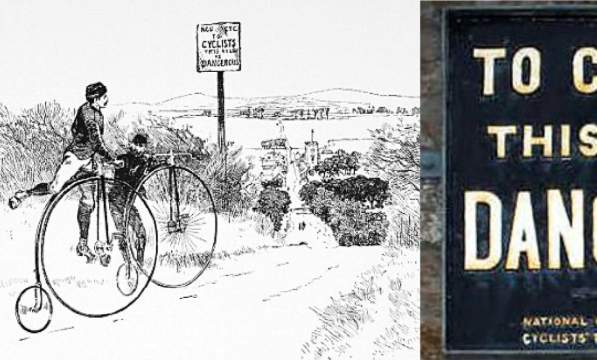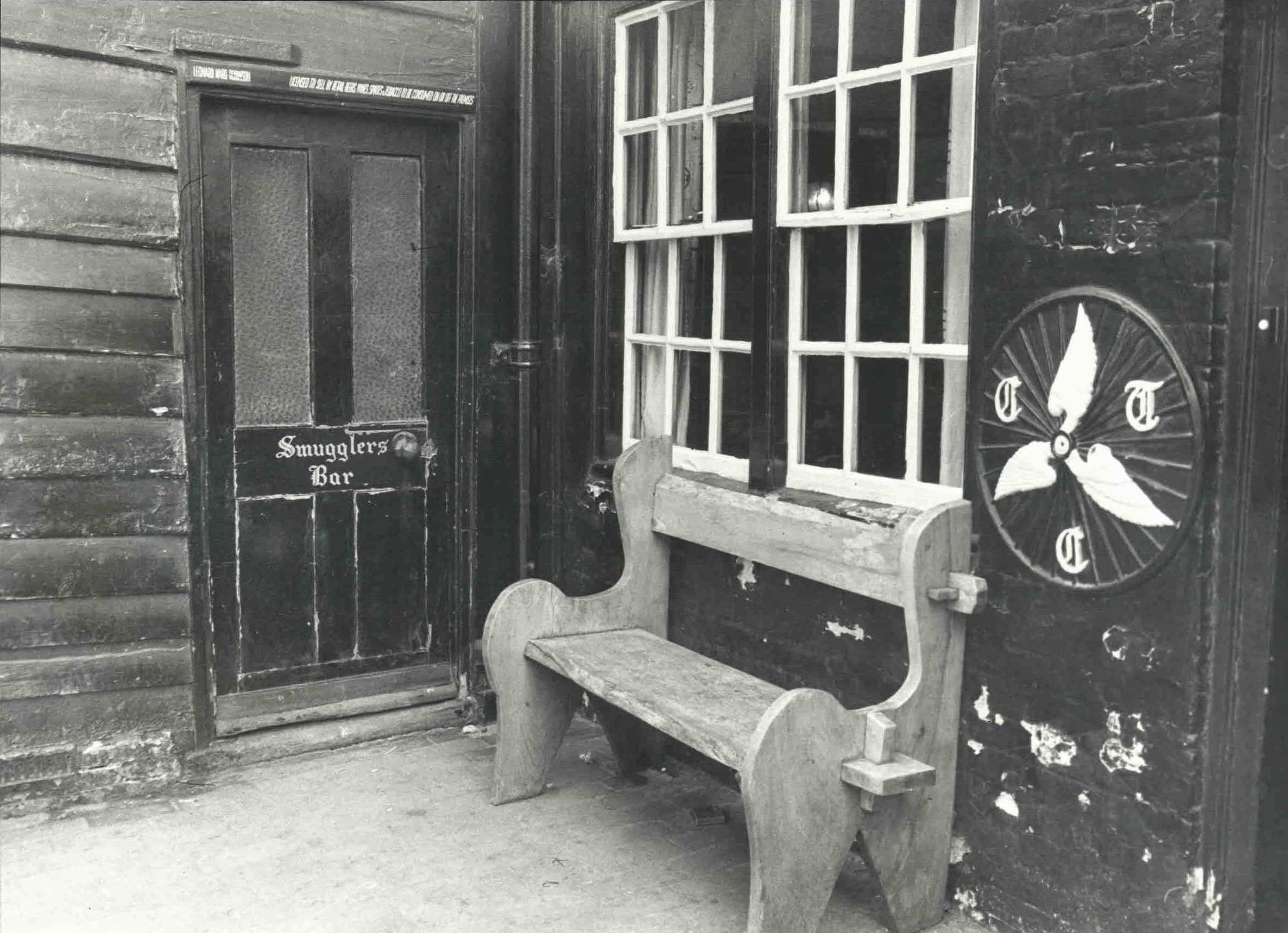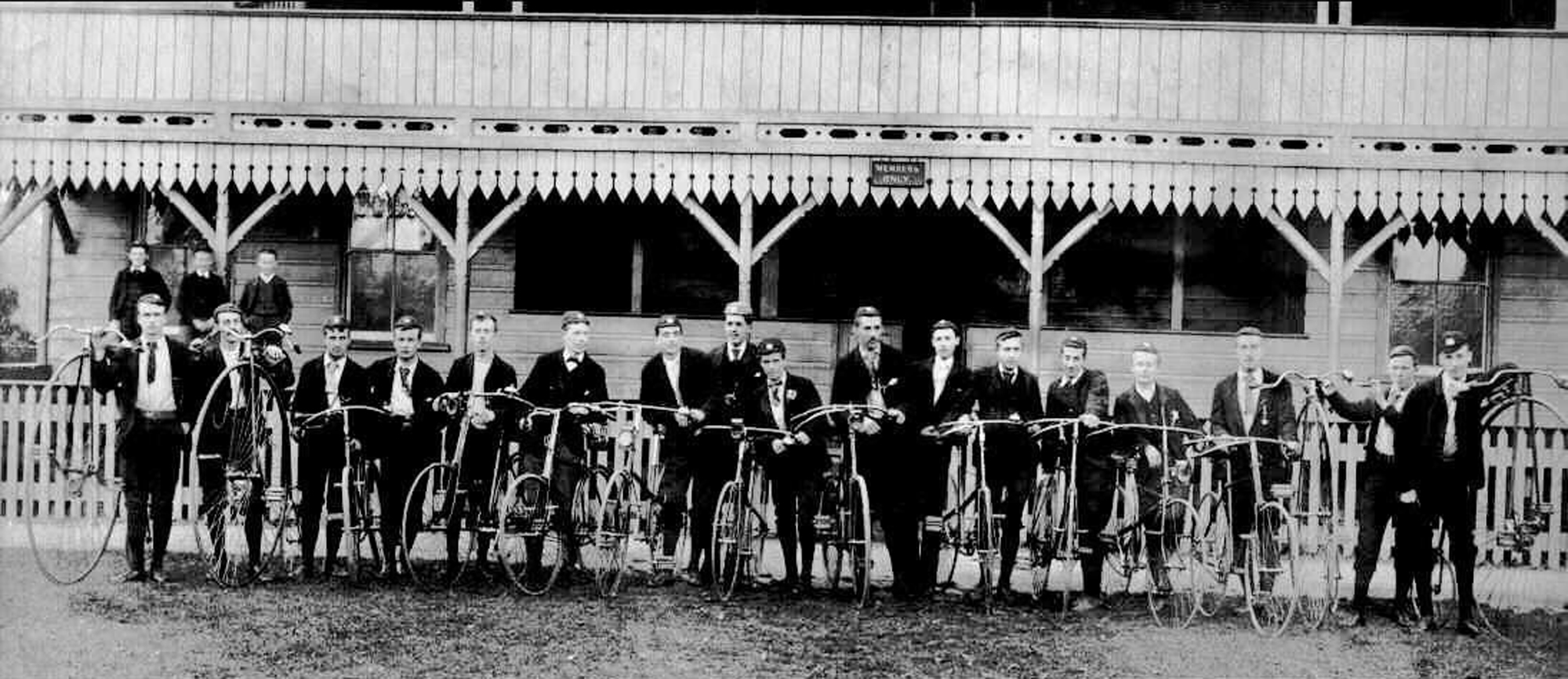This hill is dangerous! A history of Cycling UK's danger and caution boards
By Sheila Hanlon

Cycling UK was involved in putting up the first Danger signage for road users
Twenty four year old Michael Gardiner was riding to the 1895 Barnard Castle Annual Cycle Meet in when he lost control of his bicycle on Crawleyside Bank. The Northern Echo reported that Gardiner’s bicycle had become "unmanageable, and he ran with great force against a house end." Gardiner was knocked unconscious and died later than evening.
At the inquest, Gardiner’s riding companion testified that the pair were “strangers” to the road, unaware of the danger that lay a head. A thick mist on the moor concealed a steep hill and hairpin turn. They were upon it before they knew it. Tragedy soon struck. The coroner returned a verdict of “Accidental Death” and recommended that a CTC danger board be erected on the spot.
Danger boards like the one mentioned in this case were one of the CTC’s, now Cycling UK, first road safety initiatives. Long before the state took responsibility for traffic signs, cycling clubs posted warnings near steep hills and other hazards. CTC danger boards kept riders safe on the road and served as a reminder of the club’s pledge to protect cyclists even in the most remote corners of the countryside.
Development of the Danger board program
The earliest cycling danger boards date to the 1870s when highwheel associations began to form. Hills were perilous for highwheelers because their hub-mounted pedals spun out of control as the wheel accelerating down hill. It was also a long way down from the high saddle. A rough road surface, loss of balance, poor attempt to brake, or foot caught in the pedals could cause a disastrous fall. Danger signs warned cyclists to slow down and dismount before it was too late.
In 1880, the Scottish Cyclists Union began installing signs warning “Cyclists this hill is dangerous.” The President of the National Cyclists Union (NCU), The Earl of Albemarle, promoted danger boards as an accident prevention measure. The Bicycle Touring Club formed in 1878, later known as the Cyclists’ Touring Club (CTC), shared this concern for cyclists’ safety.
The CTC and NCU agreed to collaborate on a danger board program in 1883. They split the cost of a stock of signs reading “To cyclists this hill is dangerous” in white capital letters on a black background. You can see an example in the image from www.cyclingnorthwales.uk. The CTC and NCU were credited in small letters at the base of the board. The locations of newly-erected danger boards appeared monthly in the CTC Gazette.
By 1893, the NCU could no longer afford to pay its share of the scheme. The CTC took over the program entirely, designing new signs with white lettering on a red background. At some point, many signs were repainted with black letters on a white board for better visibility.
The cycling craze of the mid 1890s brought more cyclists to the roads. Safety bicycles were manageable on hills, but danger boards remained useful especially for touring cyclists in unfamiliar territory. In 1897, The CTC added a second type of sign reading “To Cyclists – ride with caution” in black text on a yellow background. Caution boards marked general hazards that could be negotiated with care such as a sudden turn, while danger boards were reserved for hills that put riders at risk.

The CTC considered expanding signage in 1900 to rapid descent, dangerous turning, level crossing, water, splash, and gate. In the end, they stuck with danger and caution. Two designs for stamped steel signs were introduced in 1902: “Danger – Cyclists Touring Club” in white text on a red background and “Caution – Cyclists Touring Club” in white text on a blue background.
A 1902 survey revealed that the CTC had installed a remarkable 2,331 danger boards and 1,989 caution boards.

Putting cycling hazards on the map: requesting a Danger or Caution sign
In the early days CTC danger board signs were installed at the club’s discretion. Responsibility later fell to CTC District Associations as part of their duty to local and visiting cyclists.
In the 1890s, anyone could apply to the CTC for a danger or caution board. To do so a concerned cyclist-citizen submitted an Application for Danger or Caution Board stating the location of the hazard, its particulars, proof of permission to erect a sign, details of who was paying for its installation, and a delivery address. An enamelled steel sign, complete with bolts, was then dispatched free of charge.
The accompanying Instructions "As To Obtaining and Erecting Danger and Caution Boards" specified that the sign was to be erected on a 12 foot tall 4x4 oak or hardwood post, sealed with two coats of good white paint, and finished with a final coat once in position. The cost of purchasing and installing a post was estimated to be 10s to 12/6.
Further guidelines suggested that “The post should be placed at the left hand side of the hill in the direction of the descent, and the Board should be about 9 feet above the ground. It should be erected in the most conspicuous place possible…at least 50 or 100 yards before the brow of the hill, and should be placed at a slight angle to the road so that it faces a rider as he descends.”

An application for a caution board dating to1898 is held in the CTC collection at the Warwick Modern Records Centre. Mr HM Rankilor requested a caution board for a hill leading from Wiveliscombe, Somerset to Brampton, Devon. It describes a “short steep descent” where “the danger lies in the number of narrow streets at the foot of hill.” The application was approved. A notice of despatch, also preserved, indicates that the caution sign was sent out to Mr W Knight.
Road safety and improvement - a longstanding CTC concern
Danger boards were part of the CTC’s commitment to road safety and improvement. In his article on the subject, historian Nicholas Oddy identifies three main purposes for cycling danger boards: 1) alerting cyclists to a danger, 2) advertising the cycling club that erected the sign and their role as responsible citizens, and 3) naming and shaming local authorities that failed to maintain safe roads. By aided bicycle tourists, danger boards bolstered mobility among cyclists. Danger signs also, Oddy points out, identified the road as dangerous – not the cyclist.
CTC danger boards had their critics. The proliferation of signs was a common complaint. An April 1898 Sporting Life article entitled “Wolf! Wolf!” declared a danger board on Barnet Hill unnecessary, adding “if these notices are stuck at the top of every little slope they will become utterly useless.” The author called CTC danger boards shameless self-promotion, not safety precautions. Others argued that the hill-friendly freewheel safety bike made danger boards obsolete. There was also a question as to the state’s obligation to cyclists who did not directly pay road rates.
In 1886, the CTC and NCU formed the Road Improvement Association (RIA) to lobby for better roads on behalf of all road users, not just cyclists. Some issues were solved by the 1888 “Local Government Act,” which made County and District Councils responsible for main and secondary roads. When motorists took to the road later in the century, they echoed cyclists’ demands for better road conditions, a concept Carlton Reid explores in his book Roads Were Not Built for Cars. Danger boards were part of the infrastructure developed by cyclists that all road users benefitted from.
Around 1900, the CTC began to de-prioritize danger boards. Club membership was in decline and finances were tight. New signs were rare and old signs were less often repaired or replaced. The official CTC danger and caution board county ledgers held at the Warwick Modern Records Centre are heavily annotated in red ink after 1900 to indicate damaged and missing signs. A note dated 22 June 1905, for example, reads “All the boards in this county have been taken down by the Somerset County Council.”
A sign of the times – state responsibility for road signage
The 1903 Motor Car Act addressed signage, but took years to implement. During this time the CTC continued to post danger boards, though at a slower rate than in the 19th century.
In the 1930s culture of road signs shifted significantly. The 1930 Road Traffic Act transferred full responsibility for signs to the government. CTC signs dating to this era show the club insignia under a red warning triangle, such as the example from Tattle Bank, Warwickshire. In 1956, the CTC was removed from the list of organisations permitted to erect danger boards. The CTC’s road sign erecting power was restored in 1981, but not widely used.
Club members and local communities often maintained CTC danger boards out of nostalgia or concern for cycling safety. An 1983 Cycletouring article by Karl Briggs featured Eddie Marshall and Angus Muire repairing a historic danger board at Cape Wrath, Scotland. When vandals absconded with the CTC danger sign from Ham Gate, Richmond Park in the 1980s, a replica of it was installed.

A few CTC signs survive today. Keith Matthews’ website dedicated to CTC signs, www.wingedwheels.info lists dangers boards at Stede Hill, Harrietsham and Spring Hill, Lincoln.
You may be lucky enough to spot a CTC danger board on your own cycling adventures. If you do come across one remember, “Cyclists this hill is dangerous!”





